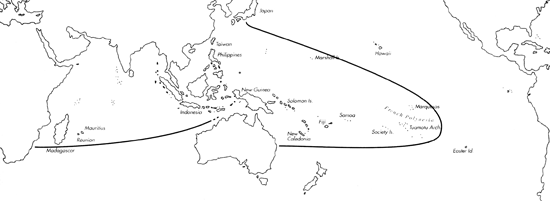Range: Indo-Pacific except for Hawaii.
Description: Moderately large to large, solid to heavy. Last whorl usually narrowly conoid-cylindrical to conoid-cylindrical, sometimes narrowly cylindrical; outline variably convex at adapical third, nearly straight below; left side sometimes slightly concave at base. Aperture somewhat wider at base than near shoulder. Shoulder angulate to almost indistinct. Spire of low to moderate height; outline slightly concave to slightly convex, with domed early postnuclear whorls. Larval shell multispiral and projecting, maximum diameter 0.7-0.8 mm. About first 4 postnuclear whorls weakly tuberculate. Teleoconch sutural ramps flat to slightly concave, with 2-4 fine spiral grooves in first 3-4 whorls, turning into numerous obsolete spiral striae in following whorls. Last whorl with rather closely spaced, fine spiral ribs basally and fine to obsolete spiral threads above.
| Shell Morphometry | ||
|---|---|---|
| L | 55-114 mm | |
| RW | 0.30-1.05 g/mm | |
| (L 55-95 mm) | ||
| RD | 0.42-0.58 | |
| PMD | 0.71-0.84 | |
| RSH | 0.09-0.15 | |
Ground colour white, often suffused with pink in shells from RĂ©union and W. Thailand. Last whorl overlaid with light do dark brown leaving numerous medium-sized to large, separate or overlapping tentlike ground-colour markings; tents concentrated in 3-4 axial bands from base to shoulder and in 3 spiral bands, below shoulder, below centre, and near base. Brown colour zones intersperced with spiral rows of alternating dark brown dashes and very small white markings. Small subadult specimens usually with alternating brown and white axial bands, the latter sparsely crossed by brown reticulated lines. Larval whorls and 1-2 adjacent postnuclear sutural ramps immaculate pinkish violet. Following ramps matching last whorl in colour pattern. Aperture white to bluish white, sometimes cream to yellow.
Periostracum yellowish brown, thin, translucent, smooth.
Dorsum of foot white, radially mottled with brown, brown markings larger and darker brown to black on lateral marginal zones; anterior part largely brown, with a median black blotch anterior to 2 lateral black blotches; posterior part with a black spot beneath the operculum; a brown pre-marginal line may be present. Sole of foot white, flecked with brown. Rostrum white, immaculate at distal edge, mottled and longitudinally streaked with brown behind. Proboscis blood red. Tentacles white; tip red to brown, with an orange-brown to black axial streak. Siphon white, mottled with brown, heavily mottled proximally, with a dark grey to black ring about 1/2 of the length from the tip; tip red (Chaberman, pers. comm., 1981; Kohn, unpubl. observ.; Pearson, unpubl. observ.) (Pl. 76, Fig. 63; Pl. 84, First row, right).
Radular tooth morphology matches that of C. pennaceus (see Nybakken, 1990, as C. episcopus).
Habitat and Habits: In shallow water to 40 m; on the lagoon and ocean sides of coral reefs, in sand and coral rubble, often beneath coral rocks (Cernohorsky, 1964; Kohn & Nybakken, 1975; Richards, 1989; Grosch, pers. comm., 1989; Tirard, pers. comm., 1989). C. episcopatus is known to feed on Cypraeidae (Kohn & Nybakken, 1975). In the E. Indian Ocean, egg diameter of 400 µm predicts a short minimum planktonic period of about 7 days; in Palau, egg diameter is 275 µm and pelagic period about 15 days (Perron & Kohn, 1985).
Discussion: C. episcopatus is so similar to C. magnificus in shell characters and body colouration that they cannot always be unequivocally distinguished and are often considered conspecific (Walls, [1979]; Richard, 1990). The latter species differs in having a finer reticulate pattern on the last whorl with a larger proportion of small ground-colour tents and in a usually higher spire (RSH 0.13-0.19). In the Pacific, where both species occur sympatrically, C. episcopatus lacks pink shades in the ground colour and the surface of its shell has a lower gloss. We therefore provisionally favour the status of separate species. C. aulicus can be distinguished by its acute and pure white apex and by its cylindrical or ovate last whorl (PMD 0.63- 0.75). For comparison with C. omaria and C. pennaceus, see the Discussions of those species. For a long time, C. episcopatus was referred to as C. episcopus Hwass, actually a synonym of C. pennaceus (Kohn, 1964). The name C. episcopus var. oblongus (based on a subadult specimen) was pre-occupied, and C. episcopus var. elongata is a nomen nudum (Coomens et al., 1986). Therefore C. episcopatus is the first available name for this species.

C. episcopatus range map
This section contains verbatim reproductions of the accounts of 316 species of Conus from the Indo-Pacific region, from Manual of the Living Conidae, by Röckel, Korn and Kohn (1995). They are reproduced with the kind permission of the present publisher, Conchbooks.
All plates and figures referred to in the text are also in Röckel, Korn & Kohn, 1995. Manual of the Living Conidae Vol. 1: Indo-Pacific Region.
The range maps have been modified so that each species account has it own map, rather than one map that showed the ranges of several species in the original work. This was necessary because each species account is on a separate page on the website and not confined to the order of accounts in the book.